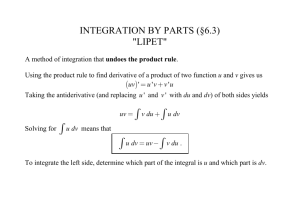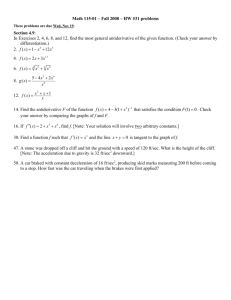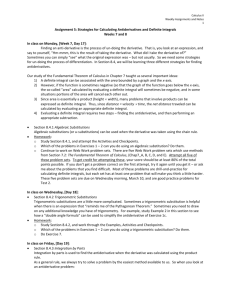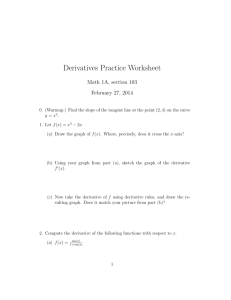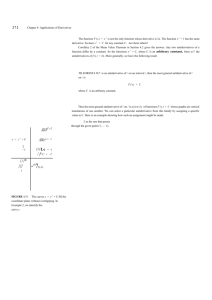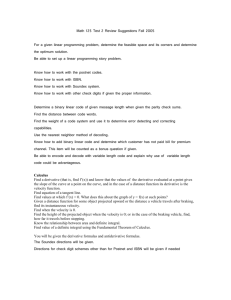Section 4.1 * Antiderivatives and Indefinite Integration
advertisement
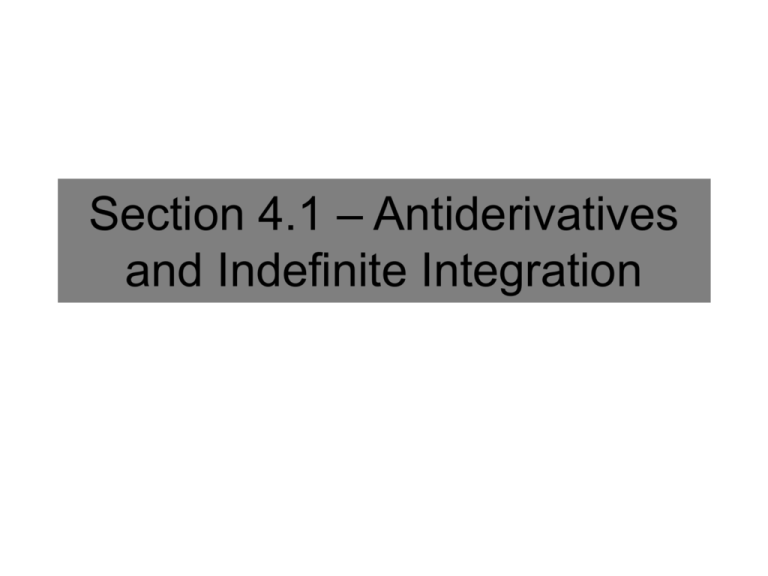
Section 4.1 – Antiderivatives and Indefinite Integration Reversing Differentiation We have seen how to use derivatives to solve various contextual problems. For instance, if the position of a particle is known, then both the velocity and acceleration can be calculated by taking a derivative: s t 3t 2 5t 7 s ' t v t 6t 5 v ' t a t 6 Position Function The derivative of the Position Function is the Velocity Function The derivative of the Velocity Function is the Acceleration Function But what if ONLY the acceleration of a particle is known? It would be useful to determine its velocity or its position at a particular time. For this case, a derivative is given and the problem is that of finding the corresponding function. a t 32 Acceleration Function v ' t a t s '' t a t What function has a derivative of 32? What function has a second derivative of 32? Antiderivative A function F is called an antiderivative of a given function f on an interval I if: F ' x f x for all x in I. Example: F x 1x is an antiderivative of f x x12 because F ' x x12 The Uniqueness of Antiderivatives Suppose f x 3x 2 , find an antiderivative of f. That is, 2 find a function F(x) such that F ' x 3x . F x x 3 Using the Power Rule in Reverse Is this the only function whose derivative is 3x2? H x x 5 K x x 11 M x x H ' x 3x 2 K ' x 3x 2 M ' x 3x 2 3 3 3 There are infinite functions whose derivative is 3x2 whose general form is: C is a constant real G x x C 3 number (parameter) Antiderivatives of the Same Function Differ by a Constant If F is an antiderivative of the continuous function f, then any other antiderivative, G, of f must have the form: G x F x C In other words, two antiderivatives of the same function differ by a constant. Differential Equation A differential equation is any equation that contains derivatives. If a question asks you to “solve a differential equation,” you need to find the original equation (most answers will be in the form y=). Example: The following is a differential equation because it contains the derivative of G: The general solution to the differential equation is: G ' x 2x G x x2 C Example 1 Find the general antiderivative for the given function. f x x5 Using the opposite of the Power Rule, a first guess might be: If: F x 16 x6 General Solution: F x x6 Then: Divide this result by 6 to get x5 But: F ' x 6 x5 F ' x 16 6 x5 x 5 F x 16 x6 C Example 2 Find the general antiderivative for the given function. f x sin x Using the opposite of the Trigonometric Derivatives, a first guess might be: If: F x cos x F x cos x General Solution: Then: Multiply this result by -1 to get sinx But: F ' x sin x F ' x sin x sin x F x cos x C Example 3 Find the general antiderivative for the given function. f x 5 x3 Using the opposite of the Power Rule, a first guess might be: If: F x 5x4 F x 54 x 4 General Solution: Then: Divide this result by 4 to get 5x3 But: F ' x 20 x3 F ' x 54 4 x3 5x3 F x 54 x4 C Example 4 Find the general antiderivative for the given function. f x 1 x 1 x1 2 x 1 2 Rewrite if necessary Using the opposite of the Power Rule, a first guess might be: If: F x x1 2 F x 2 x1 2 General Solution: Then: But: Multiply this result by 2 to get x-1/2 F ' x 12 x1 2 F ' x 2 12 x1 2 x 1 2 F x 2 x C Example 5 Find the general antiderivative for the given function. f x 2 3 cos 2 x 9 cos 2 2 x 9sec 2x 2 Multiply this result by 1/2 to get 9sec22x Rewrite if necessary Using the opposite trigonometry F derivatives: If: F x 92 tan 2 x x 9 tan 2 x Then: General Solution: But: F ' x 18sec 2 2 x F ' x 92 2 sec 2 2 x 9sec 2 2x F x 92 tan 2 x C Antiderivative Notation The notation Integral Indefinite Integral Constant of Integration f x dx F x C Variable of Integration Means that F is an antiderivative of f. It is called the indefinite integral of f and satisfies the condition that F ' x f x for all x in the domain of f. New Notation with old Examples Find each of the following indefinite integrals. a. x dx b. sin x dx c. 3 5 4 5 x dx 4 x C d. 5 1 x x C 1 6 6 cos x C dx 2 x C Basic Integration Rules Let f and g be functions and x a variable; a, b, and c be constant; and C is an arbitrary constant. Constant Multiple cf x dx c f x dx Sum Rule f x g x dx f x dx g x dx Difference Rule f x g x dx f x dx g x dx Constant Rule (zero) 0 dx C Basic Integration Rules Let f and g be functions and x a variable; a, b, and c be constant; and C is an arbitrary constant. Constant Rule (non-zero) Power Rule Trigonometric Rule Trigonometric Rule a dx ax C n x dx 1 n 1 x n 1 C sin x dx cos x C cos x dx sin x C Basic Integration Rules Let f and g be functions and x a variable; a, b, and c be constant; and C is an arbitrary constant. Trigonometric Rule Trigonometric Rule Trigonometric Rule Trigonometric Rule sec 2 x dx tan x C sec x tan x dx sec x C csc x cot x dx csc x C csc x dx cot x C 2 Example 1 Evaluate x 3 x 7 dx 5 2 x5 dx 3x 2 dx 7 dx Sum and Difference Rules x5 dx 3 x 2 dx 7 dx Constant Multiple 1 5 1 x 5 1 3 1 2 1 x 2 1 16 x 6 x 3 7 x C 7x C Power and Constant Rules Simplify Example 2 Evaluate 5 x 4sin x dx 5 x1 2 4sin x dx Rewrite 5 x1 2 dx 4sin x dx Sum Rule 5 x1 2 dx 4 sin x dx Constant Multiple Rule 5 1 1 21 1 2 1 x 4 cos x C 103 x 3 2 4 cos x C Power and Trig Rules Simplify Example 3 The graph of a certain function F has slope 4 x 5 at each point (x,y) and contains the point (1,2). Find the function F. 3 Integrate: 3 3 4 x 5 dx 4 x dx 5 dx 4 x 3 dx 5 dx 4 311 x31 5 x C x4 5x C Use the Initial Condition to find C: 2 1 5 1 C Difference Rule Constant Multiple Rule Power and Constant Rules Simplify 4 2 4 C 6C F x x4 5x 6 Example 4 A particle moves along a coordinate axis in such a way that 3 its acceleration is modeled by a t 2t for time t>0. If the particle is at s=5 when t=1 and has velocity v=-2 at this time, where is it when t=4? Integrate the acceleration to find velocity: v t 2t 3 dt 2 t 3 dt 2 311 t 31 C t 2 C Use the Initial Condition to find C for velocity: 2 1 C 2 C 1 v t t 2 1 Integrate the Velocity to find position: s t t 2 1 dt t 2 dt 1 dt 211 t 21 1t C t 1 t C Use the Initial Condition to find C for position: 5 1 1 C 1 Answer the Question: C 5 1 s 4 4 4 5 1.25 s t t 1 t 5
